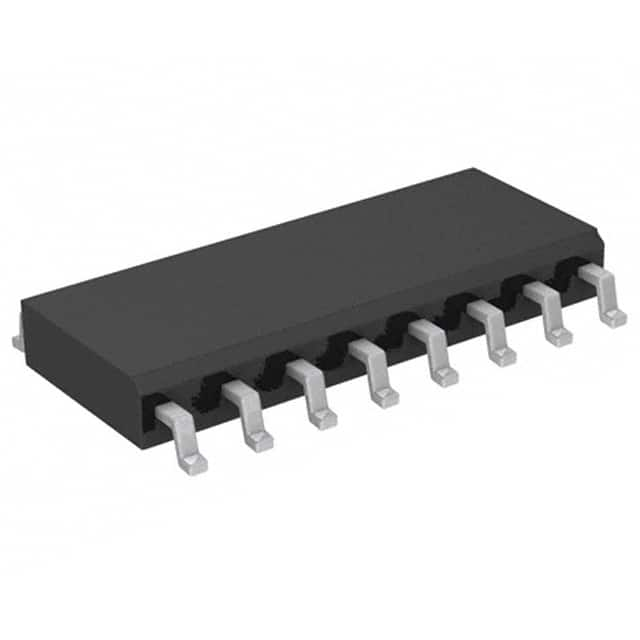74HC237D-Q100J
Product Overview
- Category: Integrated Circuit (IC)
- Use: Decoding and Demultiplexing
- Characteristics: High-speed operation, low power consumption, wide operating voltage range
- Package: SOIC (Small Outline Integrated Circuit)
- Essence: A 3-to-8 line decoder/demultiplexer with active-low outputs
- Packaging/Quantity: Tape and Reel, 2500 pieces per reel
Specifications
- Supply Voltage Range: 2V to 6V
- Input Voltage Range: 0V to VCC
- Output Voltage Range: 0V to VCC
- Operating Temperature Range: -40°C to +125°C
- Propagation Delay Time: 10 ns (typical)
- Output Current: ±25 mA
Detailed Pin Configuration
The 74HC237D-Q100J has a total of 16 pins. The pin configuration is as follows:
- GND (Ground)
- A0 (Address Input 0)
- A1 (Address Input 1)
- A2 (Address Input 2)
- E1 (Enable Input 1)
- E2 (Enable Input 2)
- E3 (Enable Input 3)
- Y0 (Output 0)
- Y1 (Output 1)
- Y2 (Output 2)
- Y3 (Output 3)
- Y4 (Output 4)
- Y5 (Output 5)
- Y6 (Output 6)
- Y7 (Output 7)
- VCC (Positive Power Supply)
Functional Features
The 74HC237D-Q100J is designed to decode three binary address inputs (A0, A1, A2) into eight mutually exclusive active-low outputs (Y0-Y7). It can be used as a demultiplexer to route data from a single input line to one of the eight output lines based on the address inputs.
Advantages and Disadvantages
Advantages: - High-speed operation allows for quick decoding and demultiplexing - Low power consumption helps in reducing energy usage - Wide operating voltage range provides flexibility in different applications
Disadvantages: - Limited number of address inputs restricts the range of possible combinations - Active-low outputs may require additional circuitry for certain applications
Working Principles
The 74HC237D-Q100J works by comparing the binary values applied to the address inputs (A0, A1, A2) with the internally decoded values. When the input values match the decoded values, the corresponding output line is activated (pulled low). The enable inputs (E1, E2, E3) control the overall operation of the decoder/demultiplexer.
Detailed Application Field Plans
The 74HC237D-Q100J can be used in various applications, including but not limited to: - Address decoding in microcontrollers and microprocessors - Data routing in multiplexed systems - Memory selection in memory devices - Signal routing in communication systems
Detailed and Complete Alternative Models
Some alternative models that offer similar functionality to the 74HC237D-Q100J are: - CD74HC238E: 3-to-8 line decoder/demultiplexer with active-high outputs - SN74LS138N: 3-to-8 line decoder/demultiplexer with active-high outputs and Schottky-clamped inputs - MC14538B: Dual 1-of-4 decoder/demultiplexer with active-low outputs
These alternative models can be considered based on specific requirements and compatibility with existing systems.
Word count: 335 words
قم بإدراج 10 أسئلة وإجابات شائعة تتعلق بتطبيق 74HC237D-Q100J في الحلول التقنية
Sure! Here are 10 common questions and answers related to the application of 74HC237D-Q100J in technical solutions:
Q: What is the 74HC237D-Q100J? A: The 74HC237D-Q100J is a high-speed CMOS 3-to-8 line decoder/demultiplexer IC.
Q: What is the purpose of the 74HC237D-Q100J? A: The purpose of this IC is to decode binary information from three input lines and activate one of eight output lines based on the input combination.
Q: What is the maximum operating voltage for the 74HC237D-Q100J? A: The maximum operating voltage is 5.5V.
Q: Can the 74HC237D-Q100J be used with both TTL and CMOS logic levels? A: Yes, it is compatible with both TTL and CMOS logic levels.
Q: What is the typical propagation delay of the 74HC237D-Q100J? A: The typical propagation delay is around 15 ns.
Q: How many enable inputs does the 74HC237D-Q100J have? A: It has two active-low enable inputs (G1 and G2).
Q: Can the 74HC237D-Q100J be cascaded to increase the number of decoded outputs? A: Yes, multiple ICs can be cascaded together to increase the number of decoded outputs.
Q: What is the recommended power supply decoupling for the 74HC237D-Q100J? A: It is recommended to use a 0.1 µF ceramic capacitor placed close to the VCC and GND pins for power supply decoupling.
Q: What is the maximum output current of the 74HC237D-Q100J? A: The maximum output current is 25 mA per output pin.
Q: Can the 74HC237D-Q100J be used in automotive applications? A: Yes, the 74HC237D-Q100J is qualified for automotive applications and meets the AEC-Q100 standard.
Please note that these answers are general and may vary depending on the specific datasheet and manufacturer's recommendations for the 74HC237D-Q100J.


